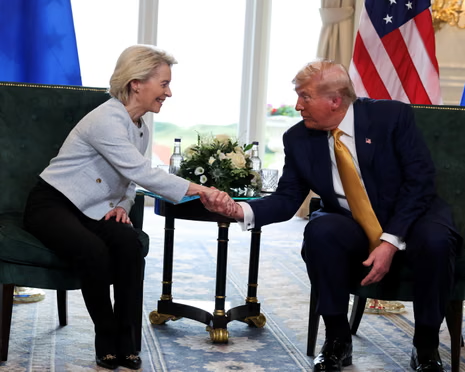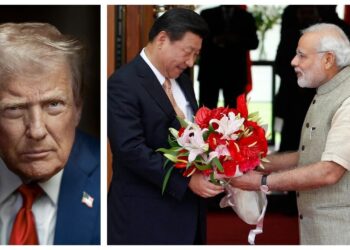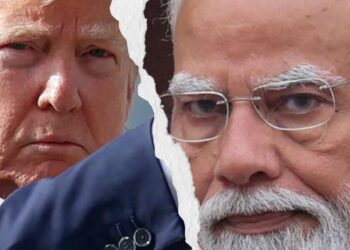ISLAMABAD (Web-Desk); US President Donald Trump on Sunday declared that the United States and the European Union (EU) had reached a tentative trade agreement after high-stakes negotiations with European Commission President Ursula von der Leyen. Speaking to reporters at his Turnberry golf resort in Scotland, Trump hailed the outcome as “a good deal for everybody,” a sentiment echoed by von der Leyen.
The announcement comes amid rising tensions over looming US tariffs that threatened to hit EU exports with levies of up to 30% starting August 1 if a deal wasn’t reached. Just hours earlier, Trump had described the odds of success as “50-50,” warning that the deadline would not be extended under any circumstances. “The deals all start on August 1,” he said firmly.
The EU, which is negotiating through the European Commission on behalf of its 27 member states, has been under pressure to safeguard a $1.9 trillion annual trading relationship with Washington. According to sources familiar with the negotiations, a framework agreement had been in place ahead of the meeting, but key issues — particularly related to tariffs and sectoral exemptions — were yet to be finalized.
An EU diplomat involved in the discussions told AFP that the proposal on the table includes a baseline 15% tariff on EU exports to the US — mirroring the level previously secured by Japan. Critical industries such as aerospace and spirits may receive special exemptions, though wine is reportedly excluded. The deal would also require formal approval by EU member states.
The diplomat noted that EU ambassadors, who were on a visit to Greenland at the time, were briefed on the developments Sunday morning and gave their broad endorsement, while still emphasizing their negotiating red lines.
The talks were hosted at Trump’s luxury resort, with the 79-year-old president expressing optimism earlier in the week about clinching what he called “the biggest deal of them all.” For the EU, the priority remains avoiding a further deterioration of trade ties that could damage its already fragile economy. Nonetheless, officials in Brussels have prepared countermeasures, including retaliatory tariffs on $109 billion (€93bn) worth of US goods, should negotiations collapse.
Details of the proposed deal also include an EU commitment to increase imports of American liquefied natural gas and expand investments in US industries. However, some sectors could still be hit hard. Pharmaceuticals — vital to Ireland’s economy — as well as semiconductors, would face the 15% tariff. A provisional agreement on steel would allow a limited quota of European steel into the US without tariffs, though Trump emphasized that no EU tariff would fall below 15%.
Currently, EU exports are already grappling with various waves of US tariffs since Trump’s return to office, including 25% on cars, 50% on steel and aluminum, and a general 10% tariff. These rates could have jumped to 30% across the board without a deal.
Uncertainty still surrounds the fate of the EU automobile sector, especially for Germany and France, as it remains unclear whether the new agreement will soften or solidify existing car-related duties.
Although a 15% rate exceeds the average pre-existing US tariffs on EU goods — which stood at roughly 4.8% — it could represent a stabilization point, especially as firms have already been absorbing an added flat rate of 10% in recent months.
Should the deal fall apart, the EU has approved counter-tariffs and is considering targeting US service sectors. France and other member states have urged the European Commission to be prepared to trigger broader retaliatory mechanisms under EU anti-coercion laws — a move that would significantly escalate tensions.
Trump’s administration has been pursuing a broader agenda to reshape US global trade relationships. Promising “90 deals in 90 days,” only a handful have been delivered so far — including agreements with the UK, Japan, and the Philippines.
US Commerce Secretary Howard Lutnick reiterated on Sunday that the August 1 deadline is final, saying, “There will be no extensions, no more grace periods.”
However, back home, skepticism about Trump’s aggressive trade strategy is mounting. A recent Gallup poll placed his approval rating at 37%, down ten points since January, suggesting that public support for his confrontational approach to trade may be waning.

























